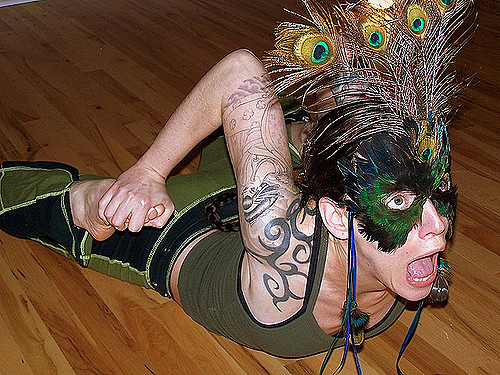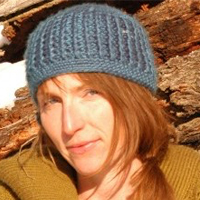A long time ago, in a studio far, far away, sat a young Canadian aspiring to be a yoga teacher.
For three months, students would arrive at the studio by 6:00 a.m. for a three-hour asana (posture) practice, followed by morning pranayama and meditation, and afternoons of anatomy and philosophy of yoga.
It was in this teacher training that I acquired my first yoga injury. There would be more, but they were sneaky and would show up as aches that would linger, rather than, say, a broken bone, torn muscle or ligament, or an inability to do something.
But that’s what it was: an injury.
My body had lost its integrity of movement and was no longer at ease because of how I was choosing to move (although I didn’t know better at the time). Since I was flexible to begin with, I could easily blow past any whispers of “no” by compensating with another part of my body—and get praised for doing so.
I was in Padmasana (Lotus pose) and my left knee was higher up in the air than my right. The senior teacher came along and said, “Stop holding yourself back,” forcing my leg down. It only hurt for a moment, but it was always achy after that. I’d sit for awhile and be sore after getting up, hobbling around because I always had to keep moving it so it wouldn’t stiffen up (I was 20 years old).
The next injury came when I was in Supta Virasana (Hero pose, where the bum is on the floor and the knees are bent with the calves beside the thighs) and again the teacher declared that I was holding myself back and put pressure down on my thighs. My knee complained, but I just watched the pain as I was told to.
I continued to refuse to listen deeply to my body and change my actions. The pain became the new normal.
All the while, I kept wondering why I was so achy after my practice. I didn’t put the two together until much further down the road.
Naïvely, I thought the instructor was right: I was holding myself back energetically.
That somehow I just wasn’t open enough. This became one of the stories I had to settle within myself. I realized that yoga isn’t about being open and okay with everything; it’s about awareness (with the realization of oneness arising from that). Being okay with everything meant also being okay with boundaries.
It took me years to untangle all those stories, subtle and not so subtle, and to get my knee and SI joints back to not being achy and sore all the time.
Turns out, I wasn’t holding myself back energetically—I was being too open and not respecting that boundaries are valuable parts of life. (Also, I wasn’t using my hip muscles to externally rotate and was compensating with forcing my knee.)
I looked back on those moments with confusion for years. Something was really unsettled within me—there was a lingering “ick” feeling. Although I eventually realized what was missing from those moments, it would take a lot of doing things contrary to my original trainings to unravel the nuances.
The unravelling began with permission.
The concept of permission (which I’ll explain more fully later) didn’t come from my yoga trainings; it came from the courses I took in applied eco-psychology.
Not only was permission missing from my practice, I found it missing from yoga in general. I had always felt hesitant about adjusting people—I didn’t want to make yoga about cookie-cutter postures, but it had never occurred to me that my hesitancy was because I innately understood that yoga was so much more than assuming a shape.
There were many things that I found confusing about what I felt yoga was versus what I was being taught.
The confusion subsided more when I understood that I didn’t actually care so much about getting into a shape. I had long bought into the practice of forcing myself deeper because that was somehow yogic—or so the story was told. It’s implied that going physically deeper into a pose is more yogic, or it’s spiritual to force the body. Even though the words “listen to your body” are spoken in the class, they aren’t portrayed or supported by action, and no one teaches how to listen to the body.
The words often felt hollow.
Permission is so much more than asking to touch someone in order to make an adjustment. Permission asks us to ask if they want our advice, our offering, our suggestion, or our insight. And sometimes students say no—they are content to have their knee past the toe. Permission means communicating at the most basic of levels.
I realized I was never asked if I wanted to go deeper (physically, or otherwise) into the pose. Instructors placed all sorts of assumptions about my body and my energy, and I unwittingly took them on. We were told to explore, but when it came to try the pose, I was almost always placed back into what the shape of the pose was supposed to be.
Because I was never asked for permission to be placed into a posture, it hadn’t occurred to me to ask my body if it wanted to go into the pose.
More broadly, I would say that permission is something that is missing from so many realms of our culture—how we treat each other, ourselves, and nature.
We live in a culture that values motivation, efficiency, power, and boldness. Getting into the pose or building our dream life is more valuable than how we get what we want and what is compromised along the way.
Taking a step back to really feel, contemplate, and listen to the boundaries (and be willing to be changed by what we see and hear) is truly an act of radicalism. Of course, the word “radical” simply means to cause great change at a fundamental level—which is exactly what a yoga practice truly does to a person.
I often see these cultural stories seeping into yoga classes. Students emerge from class confusing the distinction between bullying the body and challenging the body, as they’ve just tried to bring their toes above their head (in King Dancer pose) before their body is ready, or used their arms to leverage around in a twist to go deeper, sacrificing the SI joints in the process. The ability to hear the “no,” the whispers, the signs to slow down (yellow lights) are powered over with our ideas of what we think we should be able to do.
Asking permission is a great equalizer: It stops this story right in its tracks. It allows for a conversation to begin, one that highlights the equality of the other, whether it’s between two people, the mind and body, or nature.
Permission is a feeling of “yes!”—of ease, willingness, and full breath. It is not just the absence “no.”
A feeling of “yes” can arise even when the body doesn’t know how to do something but is willing to learn or explore, and a feeling of “no” can arise with even the most familiar of movements. Yes has a clarity to it, an organic openness and willingness.
To understand this better, think of a time when someone asked something from you; perhaps it was to come into your home. You may have felt a definite “yes” and let them in, you may felt rather unsure about it, or perhaps it was an absolute “no.” In each one of those responses, the body had a feeling that went with it, whether it was openness, uncertainty, or being closed. But in the case of the “no,” we might have also felt a need to be polite, which may have stopped that “no” and forced an opening of the door. When there’s forcing, there’s residue—a feeling of “ick” (or being uncomfortable) that may linger, even long after the visitor has left.
Asking permission means we have to stop and listen—really listen. It means we have to be vulnerable and wait to hear the answer. It means feeling deeply and being willing to change our actions based on what we hear.
And that’s where permission sets off triggers: “No” is a hard thing for many people in our culture to handle, especially since many of us have been told that we can do anything we want to do.
The “no” is valuable though. It starts a conversation that brings a deeper understanding. It’s the beginning of understanding the difference between forcing and challenging.
The desire to challenge arises naturally from a place deep within us, and when it does, it’s a beautiful thing that is supportive and powerful—not forced or forceful.
Gaining permission from the body to move into a posture is an interesting practice. It makes us stop, feel, connect, and become aware of what’s real before deciding that we ought to change something.
In my own practice, I will literally ask my body for permission to go into a pose as I feel for the “yes,” “maybe,” or “no.” Each of us has to learn for ourselves what the sensations and signals of permission are for our own body. There are sensations before, during, and after a choice that give feedback to how integral our choice was.
When I get permission and am in a posture, sometimes I’ll be there and get a “let’s go deeper” response; my body will allow me to easily move deeper into the pose. Sometimes I get a “nope,” and it becomes a struggle to stay. My body locks down and tenses up, and I have to use force to stay in that pose. I will lock down my exploration, my contemplation, get rigid (in both breath and body), and intensely focus on being where I think I ought to be. This is clearly a no. Sometimes when I am unsure, I will go slowly and explore, asking, “How about now; how does this feel; is this okay?”
If I don’t get permission, I start exploring what the “no” is about. Sometimes it’s a “not right now,” or “breathe a little longer,” or “not today,” or “get some help with this pose because something is not supportive.”
The “no” holds a lot of information and insight if we are willing to contemplate and become curious with it. The questioning is not to undermine the “no,” but rather to understand it.
A “no” can also humble us and remind us that just because we can do something, doesn’t mean it’s the most important thing to do. A “no” asks us to be aware of a boundary and our connection to the whole—to dig a little deeper and see what else we are not aware of. I’ve learned just as much, if not more, from the “no’s” than the “yes’s.”
In a culture that loves getting things done, taking the time to glean permission as part of the practice seems to (initially) stilt the flow of the asana. Eventually, though, the mere thought of an asana complete with awareness will have the body letting you know whether or not it’s appropriate. The more open the communication doors are, the easier it will be to understand when your body is giving the green light.
Author: Natalie Forrest
Image: Steven Depolo/Flickr
Editor: Callie Rushton









Read 1 comment and reply